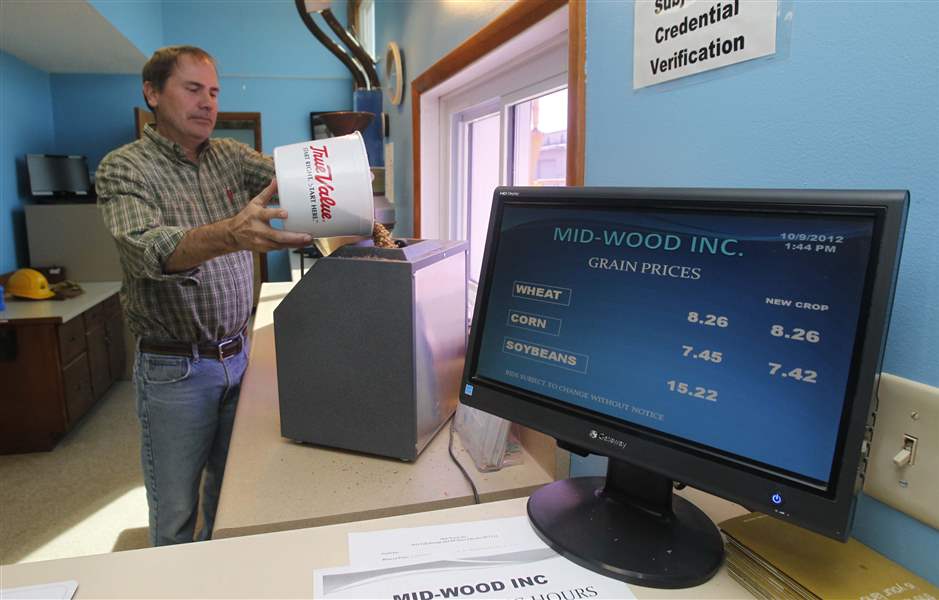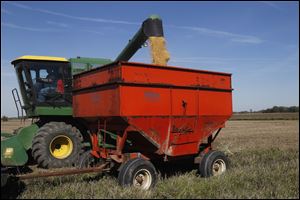
Local harvest brings relief
Farmers avoid disaster because of soybeans, insurance
10/14/2012
Kurt Dickey, Mid-Wood Inc., grain elevator branch manager, measures moisture in a load of delivered soybeans to Bowling Green grainery. While the firm says the year wasn't a bumper crop by any means, it was better than expected.
The Blade/Lori King
Buy This Image

Farmer Jim Canterbury of Portage, Ohio harvests soybeans that will be taken to the Mid-Wood Inc. grain elevator in Bowling Green. Farmers expected disaster after oppressive heat and severe drought conditions ravaged Ohio and much of the United States.
Buoyed by a better-than-expected soybean crop, high grain prices, and crop insurance coverage, most area farmers are likely to avoid calamity this year in spite of the oppressive heat and austere drought that ravaged Ohio and much of the United States, according to agricultural observers.
There’s no question this year was a rough one. After a warm spring that gave farmers a promising start, the rainfall stopped and the heat settled in, baking fields from Omaha to Columbus. At its peak, 98 percent of Ohio was under some level of drought. Rains brought significant relief to northwest Ohio since mid-August, but at that point it was too little too late to help the corn crop. Soy beans, however, did benefit from the moisture.
PHOTO GALLERY: Fall harvest on local farms
“Most of the people I’ve talked to were pleasantly surprised,” said Scott Barnhisel, vice president of the grain division at Mid-Wood Inc. “I’m not going to say it’s a bumper crop but it was better than expected. Something like that, you prepare for the worst, and anything better than the worst is acceptable.”
Mid-Wood operates five grain elevators across Wood County, including locations in Bowling Green and North Baltimore, and they’re starting to see the first of this year’s harvest. The United States Department of Agriculture said Ohio farmers had harvested 22 percent of the state’s corn crop and 23 percent of the state’s bean crop through Oct. 7.
Though it was drier than normal this summer, most of Wood County fared better than the counties to its northwest.
“We’re very fortunate,” said Douglas Pratt, who farms 400 acres in Perrysburg Township that have been in his family since his great-great-grandfather got it after serving as a soldier at Fort Meigs.
Mr. Pratt, 79, said his soybeans fared well with the rain that finally alleviated this summer’s extraordinarily dry conditions, although fields just 20 miles away didn’t receive the same precipitation totals and are still suffering.
“There’s a lot of people who are hurting,” he said.
He leases land to farmers in southern Wood County, and he estimated their yield may be down by half.
“They’re in pretty serious shape down there,” he said.
The USDA on Thursday again lowered its projections for U.S. corn production. The federal agency forecast a total U.S. production of 10.7 billion bushels — down 13 percent from last year and the lowest since 2006. Part of the reason it’s not lower is because U.S. farmers planted more acres of corn this year than in any year since 1937. The USDA expects U.S. corn yields to average 122 bushels per acre, the lowest yield average since 1995. The agency predicted Ohio’s statewide average yield at 123 bushels per acre. Normal production is about 160 bushels an acre.
Thursday’s report was a bit more generous to soy beans, bumping up the estimate 9 percent from the September projections to 2.86 billion bushels, or 37.8 bushels per acre. The USDA said Ohio farmers should see slightly better yields — 43 bushels per acre — though the projections are still down from last year, when Ohio farmers produced an average of 48 bushels per acre.
Like in real estate, farming is location, location, location.

Douglas Pratt, 79, climbs into his combine to harvest a field of soybeans on his 400 acres in Perrysburg Township. Still, he acknowledges, a lot of people are hurting.
Mike Mock, a senior risk manager and grain market global strategist for The Andersons Inc. in Maumee, said northwest Ohio’s prognosis was roughly split by I-75. To the east, there was more rain and generally better crops. To the west, things were bad.
“If you talk to someone from Fremont to Tiffin to Mansfield, east into Pennsylvania and New York, they’re very, very pleased,” Mr. Mock said.
However, Fulton, Williams, and Defiance counties bore the full brunt of Ohio’s drought.
“Those folks were decimated with corn crops that are worse than 1988," he said, referring to a previous drought year. “So it’s highly variable.”
Mr. Mock said there are pockets in Fulton County where he expects to see corn yields of 50 bushels an acre — down nearly 70 percent from the county’s average yield last year.
Some Defiance County farmers are in a similar predicament.
Chad Hall, a Defiance-based independent crop insurance agent with Spartan Insurance Agency, guesses Defiance County’s corn harvest is about a third complete, and he’s seen yields ranging from 120 bushels an acre all the way down to 20 bushels an acre. He’s figuring most will come in between 50 and 70 bushels an acre. Last year’s average was 138.
“Right here, home turf, it’s the worst crops we’ve had,” he said. “But beans are surprisingly better than expected.”
In spite of that lowered production, Mr. Mock said the average farmer is doing OK.
“The majority of them buy crop insurance,” he said. “Between a good bean crop and some sort of crop insurance coverage in corn, I think the growers are going to be in pretty darn good shape despite a very difficult June and July.”
Grain prices
For some farmers, high grain prices can more than offset the losses in production. Grain prices are up more than 20 percent.
“Its not unusual in these types of years, large yield reductions, that in fact gross revenue is higher,” said Carl Zulauf, an agricultural economist at Ohio State University.
Indeed, last month the USDA projected net farm income would rise almost 4 percent from last year, including the crop sector.
Using USDA estimates, Mr. Zulauf calculated expected average gross revenue per acre of corn and soy beans in February and compared those figures to the average gross revenue now at harvest time.
Despite per-acre corn production dropping by a quarter, gross revenue only went down $4 to $888 per acre. Gross revenue per acre of beans actually went up 6 percent to $586, in spite of a 14 percent drop in expected production.
Because of the way grain commodities are sold, not every farmer is going to get the current high price for his corn or beans. Mr. Zulauf said the calculations simply show a decline in yield does not necessarily equate to a decline in gross revenue. Still, that’s not a guarantee that individual farmers are going to be better off this year than they would have been had there not been a drought.
“What’s important to remember about saying this is we’re talking about the average producer. If you’re in an area of the country particularly hard hit by the drought, your yields are going to go down more than prices go up,” Mr. Zulauf said.
Insurance Coverage
What will help as much as anything is crop insurance.
Mr. Hall, who covers an area that runs roughly from eastern Indiana, south to Wood County and east to Sandusky County, said about 80 percent of farmers have crop insurance. The majority, he said, cover at least 75 percent of their normal income.

Kurt Dickey, Mid-Wood Inc., grain elevator branch manager, measures moisture in a load of delivered soybeans to Bowling Green grainery. While the firm says the year wasn't a bumper crop by any means, it was better than expected.
Premiums are based on individual farms, but Mr. Hall said this year an average farmer might pay $20 to $30 per acre for coverage. Premiums are subsidized by the federal government, often with the government paying more than 50 percent.
Policy types vary, but the most popular type covers drops in both yield and grain price. That type of policy pays out losses based on an average price from the Chicago Board of Trade at harvest time. The number of farmers buying crop insurance has been steadily increasing since the 1980s. Mr. Zulauf said it can be a near necessity.
“Farmers have a lot of cost riding on each acre now. In order to get financing, crop insurance has been championed by financial lenders and intermediaries as good protection against decreases in prices and yields,” he said.
Mr. Hall said farmers who elected to buy coverage this year will settle their claims and be able to farm another year.
“We’ll still have some losses,” he said. “The farmer would much, much rather have the bushels ... It would be no different than you thinking my car is kind of old so maybe I’ll crash it to get insurance money, or I wish my house would burn down. You don’t wish things like that. If the guy has the bushels he’d much rather take them than make a crop insurance claim.”
Where the production losses will really be felt are on the users of grain products — whether it be dairy producers, meat producers, or processed food producers. On top of price increases, there will be logistical issues of getting grain from where it is to where it isn’t. Already, he said, corn is being shipped up the Mississippi river from the deep south, the inverse of what normally occurs. “We’ll figure it out. But you have to anticipate six to 12 months from now that we’re probably going to have some impacts in secondary markets,” Mr. Mock said.
Blade staff writer Rebecca Conklin Kleiboemer contributed to this report.
Contact Tyrel Linkhorn at: tlinkhorn@theblade.com or 419-724-6134.